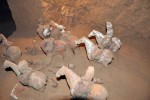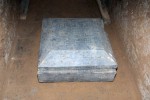 The tomb of one of ancient China’s most powerful and accomplished women, 7th century poet, politician and imperial consort Shangguan Wan’er, has been found near the airport in Xianyang City, Shaanxi province, northwest China. The tomb is approximately 118 feet long, 33 feet deep, has five skylights and vaults off a central corridor. It was badly damaged at some point, probably in antiquity, and not just by casual looters. The destruction of her tomb appears to have been part of a deliberate campaign by political enemies. Few artifacts were discovered — no precious metals or human remains — but the ones that did survive are important: a set of ceramic horsemen on their steeds and a memorial tablet inscribed with an epitaph identifying the tomb as that of “the late Zhaorong [imperial consort] Madame Shangguan of the Great Tang dynasty.”
The tomb of one of ancient China’s most powerful and accomplished women, 7th century poet, politician and imperial consort Shangguan Wan’er, has been found near the airport in Xianyang City, Shaanxi province, northwest China. The tomb is approximately 118 feet long, 33 feet deep, has five skylights and vaults off a central corridor. It was badly damaged at some point, probably in antiquity, and not just by casual looters. The destruction of her tomb appears to have been part of a deliberate campaign by political enemies. Few artifacts were discovered — no precious metals or human remains — but the ones that did survive are important: a set of ceramic horsemen on their steeds and a memorial tablet inscribed with an epitaph identifying the tomb as that of “the late Zhaorong [imperial consort] Madame Shangguan of the Great Tang dynasty.”
Shangguan Wan’er (664–710) was born to privilege but in turbulent times. Her grandfather Shangguan Yi was chancellor under Emperor Gaozong. The year his granddaughter was born, Shangguan Yi got in trouble with Empress Wu. Emperor Gaozong had expressed concern about her ever increasing power at court and his chancellor advised that the empress be deposed. When Empress Wu found out, her weasel husband blamed it all on Shangguan Yi. She and her allies accused the chancellor of conspiring with the crown prince to overthrow the emperor and had the lot of them, including Shangguan Yi and his son, Shangguan Wan’er’s father Shangguan Tingzhi, executed.
The infant Shangguan Wan’er and her mother Lady Zheng survived the palace intrigue but were enslaved. Lady Zheng saw to her daughter’s education and the child’s literary abilities became evident at a young age. She was 13 years old when Empress Wu encountered her poems and was so impressed with her abilities that she appointed the teenager her personal secretary. Shangguan Wan’er was 19 years old when Emperor Gaozong died in 683 and Empress Wu became first the power behind her sons thrones, and then, after deposing both of them in turn, the power in the throne. She declared herself emperor in 690, officially ending the Tang Dynasty and starting the Zho Dynasty.
 As the empress/emperor’s secretary, Shangguan Wan’er wielded genuine political power. She drafted imperial edicts, handled petitions from imperials officials and served as an adviser to Empress Wu on matters of state. Many of the articles about this find describe her as China’s first female prime minister because her role was so prominent and she was so close to the empress that in effect her position was more akin to a prime minister than a scribe.
As the empress/emperor’s secretary, Shangguan Wan’er wielded genuine political power. She drafted imperial edicts, handled petitions from imperials officials and served as an adviser to Empress Wu on matters of state. Many of the articles about this find describe her as China’s first female prime minister because her role was so prominent and she was so close to the empress that in effect her position was more akin to a prime minister than a scribe.
In 705, Empress Wu was deposed in a coup and replaced with Emperor Zhongzong, one of the sons she had deposed. Shangguan Wan’er ably changed sides and became one of the new emperor’s concubines, at the Jieyu or 14th rank. He recognized her skills too, so Emperor Zhongzong utilized her experience and famously beautiful prose in the drafting of edicts. She had several affairs with members of the royal family and became a confidante of Emperor Zhongzong’s wife Empress Wei. So powerful a figure was she at this court too that she was singled out for arrest during a failed 707 coup attempt. The next year the emperor promoted her to Zhaorong, a sixth rank concubine.
The emperor died suddenly, probably of poisoning, in 710. In the month after his death, Empress Wei’s faction set up a system where she would rule as regent for her son. Shangguan Wan’er’s part in this cunning plan was to draft a fake pre-dated will in which Emperor Zhongzong left the throne to his son and the regency to the empress dowager. The exclusion of Li Dan, Prince of Xiang, from this plot ensured its failure. Li Dan’s son launched a plot to overthrow the empress. This coup Shangguan Wan’er did not survive. She attempted to buy her survival by handing over Emperor Zhongzong’s original will, but it didn’t work. She was dragged out of her home and beheaded on the spot.
Despite the coups and power shifts that kept the court hopping for years, Shangguan Wan’er’s gifts were readily acknowledged by subsequent emperors. In 711, her titles were posthumously restored to her and a few years later the emperor had her literary works collected and published.
There’s some decent video of the tomb in this news story and some photographs in this slideshow.